| Cover Story
Reaching the most isolated
Elita Karim
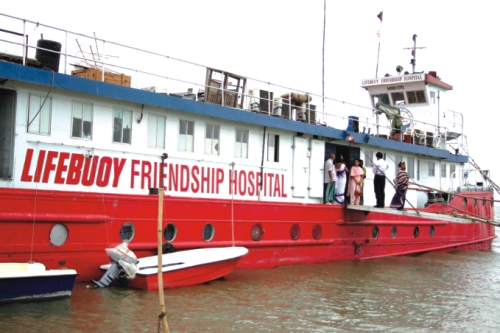 
The sight of the MAF Europe seaplane hovering above the char steals everyone's attention on the island. As the plane descends on the river children run to the banks to view the strange flying boat. Some of the older children even swim across to the other side of the river to help Marco Koffman, the pilot, to 'park' the seaplane after the passengers get off. The passengers get on a speedboat to go across the river. It is their turn to be awestruck now, when the sight of the floating hospital greets them. What is even more striking is the crowd of men, women and children waiting for their turn to see the doctor. An area of the island is filled with makeshift tents where the patients are camping for days, getting treated or just recuperating after an operation.
It is difficult to imagine an island so remote; devoid of electricity, running water, communication with the 'real' world so far away. These islanders practically live in the middle of nowhere, in tin-roofed homes or mud huts, surrounded by miles and miles of deserted sea. It is no wonder that these people are not only awestruck by the strange flying boat and the visitors to the island; they are also overwhelmed with gratitude by the fact that there are people who have bothered to bring much needed medical care to them with so much effort.
"Our flagship project is the floating hospital that we have by the chars, sponsored by Unilever Bangladesh Limited. It is called the Lifebuoy Friendship Hospital," says Runa Khan, the Executive Director of the Friendship project. In 1994, Yves Marre, a French Adventurer (Runa's husband) came to Bangladesh with a river barge, a 380 ton oil tanker as a 'World Premiere' to have it converted into a floating hospital. "We had the ship," explains Runa. "When we decided to use it to bring health care to the remotest people in Bangladesh. We naturally approached many donors, companies and multinationals for the funding and sponsorship. Because the idea of a mobile hospital rendering health care in these areas was so new, it got rejected. However, Unilever understood the need for it and decided to help out." "Eventually," she adds. "The superstructure was built, the renovations made and the dream of the mobile hospital, reaching these chars was realised." Not only does Unilever pay for the primary health care on the chars, they also cover the administration expenditure and finance four of the 36 satellite programs every month on 32 islands in the northern areas of Bangladesh.
As an organisation, Unilever Bangladesh Limited concentrates its voluntary initiatives in three areas: Health, Education and nurturing talent and Women's empowerment. "The idea of a floating hospital merged nicely with Unilever's voluntary initiatives in the area of health and Lifebuoy's health and hygiene theme. And this is how it all started," says Sanjiv Mehta, the Chairman and Managing Director of Unilever Bangladesh Limited, The project started in March 2002 and Unilever Bangladesh Limited has been sponsoring it ever since. The initial cost to set up the project was Tk 8 million. An additional amount of Tk 2 million was spent for a dental unit in 2004. Unilever Bangladesh Limited bears almost all the operating expenses of the hospital, which comes to about Taka 8 to 9 million a year.

"The co-sponsors for secondary care in this project are Emirates Airlines, MAF and Pan Pacific Sonargaon Hotel, flying the doctors in and out of the country, within the country and keeping them for a day or two respectively, before they move on to the chars," explains Runa. "In our satellite programmes, we bring in professionals for health and rural social education, provide paramedical cares, give special treatment for mother and child health, family planning and pregnancy hazards, child nutrition and identify needs for secondary care interventions and many other issues," she says. "For a satellite programme, we don't need a permanent building or anything of the sort," she explains. "We simply gather people under a shade or a village house or build a makeshift platform and educate the islanders on the basic health issues. We also run 10 schools for the children on 10 chars, in prefabricated buildings, for which we have trained local island based teachers."
According to Runa, the floating hospital stays for about one to two and a half months on one island, before moving on to the other islands in the area, depending upon the weather conditions. "During heavy rain and storms, our ship stays on the chars and carries on with the basic health programmes. Though we stop all the major surgical interventions, minor operations are carried on the ship everyday," Runa remarks. "It is simply not possible to have secondary care during this period as the heavy storms make the ship sway to and fro."
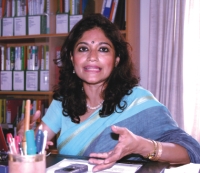 Runa Khan, Executive Director of the Friendship Project |
Besides Unilever, there are other organisations that donate for the secondary health care camps. "I have different organisations coming up to support the NGO," she says. "This time I have The Ispahani Group helping Friendship with all the operations conducted specially for children. Last time, I had HSBC who had donated for all the eye operations and JOAC (Jersey Island Overseas Aid) funded all the supporting boats, for instance the doctor's living quarters. The Danish Embassy has donated a satellite boat as well. We also get private donations from close friends and acquaintances which are always welcome," she smiles. "I had approached several local pharmaceutical companies but they have not been of much help," remarks Runa. "It's very disappointing since they all claim to give a certain percentage in charity. But it seems these charities are limited to areas where their goods are marketable and not always in genuine areas of need."
The floating hospital sails up to the chars, or as Runa calls them the Nomadic Islands, in the North of the country, where other NGOs were unable to settle due to difficulties of reaching remote areas and continue sustainable work due to the geographical nature of the shifting lands. The floating hospital sails to the chars in the Gaibandha, Kurigram, and
 Local medical - professionals treating women and children |
Jamalpur areas, covering more than 90 chars for primary and secondary health services. At least 200-250 patients come in everyday for general care and also major surgeries. Approximately 40 operations, namely cataract, burn, dental, cleft lips, hernia and many more, are performed on an average, over a week. The ship is well equipped with the latest X-ray machines, separate units dedicated to ENT, dental, surgical, gynaecological, pathology and general health. International specialists from the Swedish Doctor Bank, Humaniterra from France and Dutch medical groups fly in to train local doctors and carry on with the operations. They help our doctors give secondary level surgical interventions to the people of these remote areas every year, where the patients have never seen a doctor before. Health care services on a paramedical level are also provided to over 32 chars every month with the help of local doctors, health educators and satellite programmes. The Char Livelihood Project of the British Government has recently agreed to sponsor this programme. Satellite paramedics move all around the year in boats from one island to another rendering family planning, health education, rural social education, paramedical cares and peer training. "We have local professionals who come in to talk to these islanders about reproductive health care," says Runa Khan. "Child health care, adolescent care, communicable disease control, for example, STD, HIV, referral service for needed interventions with our hospital, behavioural change and communication and counselling for social issues and problems as well." In the social education classes, the islanders are taught about family planning, female education, hazards of child marriage and values of life and respect for those around them. "In fact, there are some areas that are under the jurisdiction of the Government, where issues like family planning and social education are to be handled by government officials," Runa explains. "However, many of the thanas in the Nomad Islands and the Riverine areas in the district of Gaibandha and Kurigram have been allocated to Friendship by the Government for our exclusive work on family planning issues."
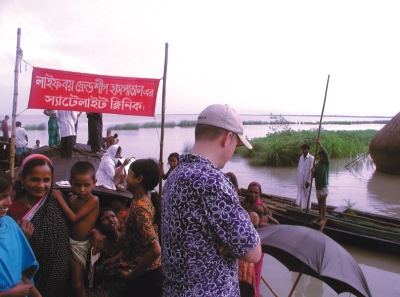
One of the many satellite projects on the chars. (billow)
Sitting in one of the makeshift camps near the hospital, on Kalashona char, 13-year-old Rehana is healing from an operation, which was done the day before. "Her right arm was burnt when she was 4 years old," explains Rehana's mother. "She fell into the cooking fire when she was checking on it in the kitchen." Rehana and her mother came from a small village quite far from the island when they heard of the Friendship hospital from relatives. "We have been camping here with the rest of the patients for the last 12 days," she explains. "We will go home within a couple of days or so."
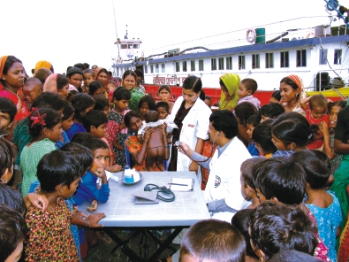 Islanders gathering around for a routine medical check up |
Two-year-old Kauser, who was born blind, is resting after having a cataract operation three days ago. "We came from a village 60 miles away," says Kolpona, Kauser's mother. "We have been camping here for the last 10 days waiting for Kauser's turn for the operation." Thank fully, they have distant relatives in Kalashona char, explains Kolpona's brother Murshed Ali. "We bring in our food from our relative's house and spend the nights here in the camps. The rest of the waiting families either make their own food or bring it with them from home."
Forty-year-old Nurjahan is quite happy she is leaving the hospital after 12 days of camping with her husband who just had a hernia operation. "The doctors operated on my husband five days ago," she explains. "He has been kept under medication till he is well enough to go home."
There is a long queue in yet another tent where the local volunteers are giving out prescribed medicine to the patients. These patients inform that they come from far and near when they figure out which char the floating hospital is stationed at. "I have been here for the last 15 days and have been given my medicine on time," says 37-year-old Jasim. "That's something that we don't get to see in our local hospitals even in the cities. All the patients here are being treated well and also more or less, kept under check on a regular basis by the doctors."
"Sometimes, situations get very difficult to handle as we get hundreds of patients waiting throughout the night, through storms and sometimes temperatures of 3 degrees" admits Runa. "So many patients and their families come to the hospital, leave alone mere spectators. We are very strict in terms of discipline, rules and order. Our single most achievement has been the trust of the people that we provide services to. Thankfully, we have never faced any serious problems. I feel safer here in the chars than in the cities. We have never had looting and theft since everyone knows us and supports us. And if minor problems do arise, the local people of the chars jump right in to help without even being asked to."
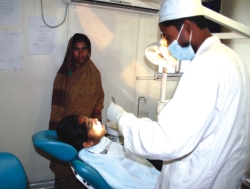 |
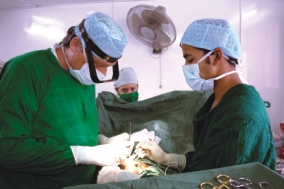 |
| A surgery in the Dental unit of the floating hospital |
An eye operation in progress |
How do these islanders survive the harsh storms and the heavy showers, not to mention floods? "Some of these islanders have boats of their own, moving to safety to the mainland," explains Runa. "However, most of them cannot afford such kinds of provisions, so they either move to the highest point of their sunken island or spend between weeks to months on a high landing that they build inside their huts or on the roofs of their houses." Even then, lots of lives are lost in these torrential rains. Though relief is sent from all over the country to Gaibandha and Kurigram, none of them reach these poor islanders since they simply cannot sail all the way to the mainland to collect them. "Something you have to realise is that you cannot fight the climatic conditions in these areas," she explains. "All you can do is help the survivors with relief and lessen the impact of a drastic situation, but you cannot avoid it. During the last flood in 2004, we had trucks filled with packaged food and medical supplies sent all the way to Gaibandha, Kurigram, Jamalpur and Pabna, which were then loaded onto boats and transported to the chars. We would then go to these chars ourselves to keep a check on the distribution of the supplies and maintain a database." Runa recalls the day when two children fell off into the river right in front of her eyes and were pulled away by the strong currents. "We sent out all our boats to look for them," she says. "But I knew it was of no use."
Friendship has yet another floating hospital under construction which is being made locally in Dhaka. "We have a contract with Emirates Airlines Foundation who is financing 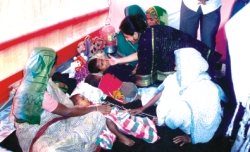 the second floating hospital," she explains. "If everything goes well, we will have the Catamaran (a boat with two hulls for stability, size and speed) by the middle of 2007." Friendship is also going to have the first river ambulance made. "It is being designed by the famous naval architect in the world today, Marc Van Peteghem," informs Runa. "His multi hull boats have won all the cross-Atlantic boat races in the last 4-5 years." the second floating hospital," she explains. "If everything goes well, we will have the Catamaran (a boat with two hulls for stability, size and speed) by the middle of 2007." Friendship is also going to have the first river ambulance made. "It is being designed by the famous naval architect in the world today, Marc Van Peteghem," informs Runa. "His multi hull boats have won all the cross-Atlantic boat races in the last 4-5 years."
"Sometimes we need to make harsh humane decisions, such as asking the doctors to be honest with the poor mothers with children who cannot be cured," she says. "There was a mother who had come in with her child suffering from Cerebral Palsy, a disease that damages the brain. The child becomes an overgrown infant who cannot do anything by himself. Therapy helps but does not cure. I had to request the doctors to tell the mother the truth; otherwise she would eventually go to a quack or probably trust a doctor who would want to take advantage of her situation by giving her hopes of curing the child. When this mother came to know of her child's situation she came up to me asking what she would do with the child. I felt absolutely helpless when the delirious mother suggested killing her own baby as a probable solution. Being a mother of three, I could feel the torture that she was going through within and spent several nights crying over such a feeling of helplessness that we have to endure sometimes." The child is still alive and comes to the ship for minor ailments.
However, there are also many happy endings the hospital has made possible. As Runa Khan takes her visitors around to meet the patients, she speaks of a 3-year-old child who would not stop smiling, looking surprised with everything he laid his eyes on. "The child was born blind," she explained. "He was operated on a week ago, and ever since he opened his eyes, everyone around came to see his expressions of surprise. He was literally looking at the world, including his parents, for the very first time." The Lifebuoy Friendship floating hospital is more like a precious gift to these islanders. A foreign reporter had once asked one of the waiting patients as to why they always came from far away places to this particular hospital, informs Runa. "Because we get better," was the simple reply.
 |
 |
| Recuperating after a burn surgery |
Two-year-old Kauser trying to see the world with his new eyes |
Friendship in other areas:
*Relief and Rehabilitation: Due to constant flooding during heavy rain and storms, food and essentials are reached to the marooned islanders over the districts by boats. "We have also been working to providing expertise and direct help for any emergency relief work within the country," adds Runa. "Be it for natural or man made disasters." An innovative project of risk sharing credit and micro saving is being implemented now, started by the Friendship Char Development Committees (FCDC), and sponsored by Carrefour Foundation. "This is a new method based on old concepts, for empowerment of
 Educating mothers on general health and pregnancy hazards |
the poorest of the poor to be more or less self-sufficient in food in 3-5 years," says Runa. "This will eventually help the islanders with communication, agriculture, livestock and capacity building." The flood washes over the houses forcing the Nomad Islanders to live under 3-4 feet of water for weeks and sometimes months. Plinth raising, designed by the Friendship Research Group is being piloted for 82 households over 3 Nomad Islands which will eventually be expanded over to more islands. *Education: The Friendship Education project has 10 schools in 10 chars, which are modelled keeping in mind the natural geography and limitations of the area. The Friendship Educational Programme, in cooperation with FIVDB, sponsored by Erikshjalpen of Sweden, to date has enrolled 360 children and is expecting another 300 in the up coming session. Rural Social Education is also something that Friendship emphasises on, bringing awareness of the Rights of Respect and Values to the people of the area amongst themselves in their social context through the satellite programmes and through the education programme.
*Cultural Preservation: This unique project, sponsored mainly by the Bengal Group and the German Embassy, aims to bring back the pride of the National Heritage of the boat builders throughout the country by bringing awareness of this technology to the world through the Living Museum of Country Boats by the River Dhaleswari in Savar.
Copyright
(R) thedailystar.net 2006 |
|
